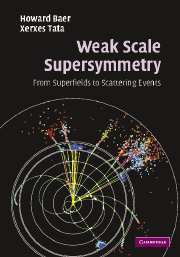Book contents
- Frontmatter
- Contents
- Preface
- 1 The Standard Model
- 2 What lies beyond the Standard Model?
- 3 The Wess–Zumino model
- 4 The supersymmetry algebra
- 5 Superfield formalism
- 6 Supersymmetric gauge theories
- 7 Supersymmetry breaking
- 8 The Minimal Supersymmetric Standard Model
- 9 Implications of the MSSM
- 10 Local supersymmetry
- 11 Realistic supersymmetric models
- 12 Sparticle production at colliders
- 13 Sparticle decays
- 14 Supersymmetric event generation
- 15 The search for supersymmetry at colliders
- 16 R-parity violation
- 17 Epilogue
- Appendix A Sparticle production cross sections
- Appendix B Sparticle decay widths
- Appendix C Higgs boson decay widths
- Bibliography
- Index
8 - The Minimal Supersymmetric Standard Model
- Frontmatter
- Contents
- Preface
- 1 The Standard Model
- 2 What lies beyond the Standard Model?
- 3 The Wess–Zumino model
- 4 The supersymmetry algebra
- 5 Superfield formalism
- 6 Supersymmetric gauge theories
- 7 Supersymmetry breaking
- 8 The Minimal Supersymmetric Standard Model
- 9 Implications of the MSSM
- 10 Local supersymmetry
- 11 Realistic supersymmetric models
- 12 Sparticle production at colliders
- 13 Sparticle decays
- 14 Supersymmetric event generation
- 15 The search for supersymmetry at colliders
- 16 R-parity violation
- 17 Epilogue
- Appendix A Sparticle production cross sections
- Appendix B Sparticle decay widths
- Appendix C Higgs boson decay widths
- Bibliography
- Index
Summary
At this point, we have all the ingredients necessary for constructing a supersymmetric version of the Standard Model, complete with explicit soft SUSY breaking terms. The simplest such model, known as the Minimal Supersymmetric Standard Model, or MSSM, is a direct supersymmetrization of the Standard Model (except for the fact that one needs to introduce two Higgs doublet fields). It is minimal in the sense that it contains the smallest number of new particle states and new interactions consistent with phenomenology.
To construct the MSSM, we follow the recipe for the construction of supersymmetric gauge theories at the end of Chapter 6 and proceed as follows:
We choose the gauge symmetry group for the theory to be the Standard Model gauge group, SU(3)C × SU(2)L × U(1)Y.
We select the matter content of the theory, to be realized as left-chiral scalar superfields, with gauge quantum numbers exactly as in the Standard Model. The Higgs sector is chosen to consist of two left-chiral scalar superfields with opposite hypercharge.
We choose the form of the superpotential.
Finally, we compute the supersymmetric Lagrangian using the master formula Eq. (6.44), and augment it by all possible soft SUSY breaking terms consistent with the gauge and Poincaré symmetries as discussed in Chapter 7.
Constructing the MSSM
As mentioned, we choose the gauge symmetry of the Standard Model: SU(3)C × SU(2)L × U(1)Y. The gauge bosons of the SM are promoted to gauge superfields.
- Type
- Chapter
- Information
- Weak Scale SupersymmetryFrom Superfields to Scattering Events, pp. 127 - 189Publisher: Cambridge University PressPrint publication year: 2006
- 1
- Cited by



